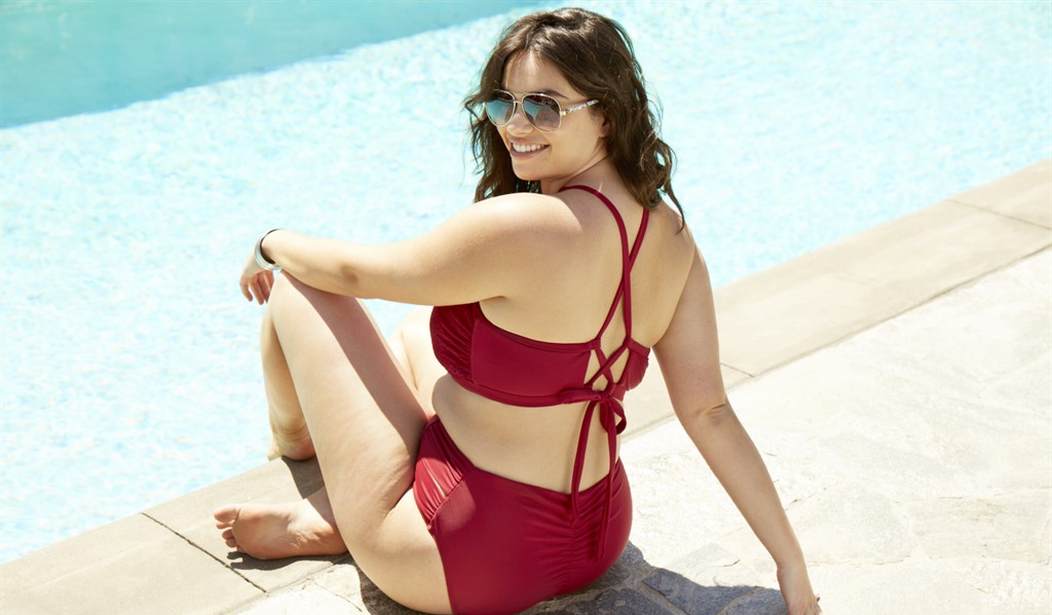Back in the days of yore, the Sports Illustrated Swimsuit Edition was reserved for the pinnacle of beauty and sexiness. The covers would make men stop and stare. They were collectors’ items and when a new annual cover dropped it was something of a public stir. Hannah Davis, Kate Upton, Elle McPherson, Marrisa Miller, Tyra Banks, and even Beyonce had all graced the covers and made the public redefine perfection again and again.
But Sports Illustrated, like many publications, went woke, and soon they began utilizing their most anticipated issue to push a political narrative. In 2021 they made Leyna Bloom, a transgender person, their swimsuit model. Now, this year, the woke seemed to have returned to remembering what a woman is but have decided to push the “healthy at any size” narrative by making Yumi Nu their model.
As you can see, Nu doesn’t mirror the body perfection of Banks or Upton. She’s what the artist would call “Rubenesque” and what the politically correct doctors would call “well-nourished.”
Yumi Nu 'shaking' over SI Swimsuit cover reveal https://t.co/g1yXu8NKhX pic.twitter.com/CQC3ELLW2F
— New York Post (@nypost) May 16, 2022
Naturally, this kicked off a firestorm of debate. As you can see from the New York Post’s comments on this tweet, people are fighting over what is considered to be beautiful and/or healthy. It’s a flame war that doesn’t divide by political lines either. People on the right are just as apt to defend this cover as they are to denounce it.
One such denunciation comes from Jordan Peterson, who wasn’t exactly kind to it.
Sorry. Not beautiful. And no amount of authoritarian tolerance is going to change that. https://t.co/rOASeeQvee
— Dr Jordan B Peterson (@jordanbpeterson) May 16, 2022
Peterson’s tweet is actually nicer compared to a lot of other comments on it, but it does represent the base argument against Nu’s presence on the cover. Firstly, it addresses the change in the standard for beauty, and secondly, it addresses the political push behind the change.
“Beauty is in the eye of the beholder,” they say. There will be quite a few men who look at Nu on the cover and salivate like a cartoon wolf. There are plenty of men out there who like a woman with a bit more meat on her bones and Nu definitely is providing more portions compared to someone like Miller.
But here’s where we need to become a bit less kind and a lot more realistic.
Nu is 25-years-old at a height of 5’11. Various sources seem to disagree about her weight but the most common one I see hovering around is that Nu is somewhere around the 242 lb mark. Others list her as 5’6 at 160 lbs. Either way, neither of these weights is considered medically healthy. According to the BMI chart, Nu is either obese or overweight respectively. She is, according to our current understanding of modern health, at an unhealthy weight.
Sports Illustrated went from displaying body perfection to problematic bodies.
One could make the argument that SI was never truly displaying good body types in the first place as the vast majority of women would never look like Upton, and these people would be correct. Upton’s job is to be a model. She has nutrition advisers, works out constantly, and has the time to dedicate to being at the peak of fitness.
Most women simply don’t. They’re busy going to work, raising children, running a household, going to meetings, organizing events, and more. They might get to the gym once or twice a week if they can get there at all. They don’t have nutrition advisers and personal coaches. The truth is, more women are likely to look like Nu than Upton. According to Healthline.com, the average American woman weighs 170.6 pounds.
America has an obesity issue, and that’s not new news. Our diet, compared to other countries, is packed to the brim with sugars and carbs, and many of us would rather spend our downtime parked in front of a screen than doing anything that involves physical activity. There’s a host of reasons for this, but that’s another article.
The inconvenient fact is that the average weight of American women isn’t a good thing, and yet it’s being celebrated on the cover of a yearly magazine issue reserved for the epitome of beauty and body achievement. Moreover, it’s being done in the name of politics. There’s no grounding for this by any other standard. The fact is, if you were to ask 100 men whether or not they’d rather look at Nu or Upton, the vast majority would answer “Upton.” If you were to line the same number of women up and asked them who they would rather look like, the vast majority would also answer “Upton.”
Truthfully, this is a result of a social justice push for body acceptance. The “healthy at any size” and “big is beautiful” narratives are rooted in modern feminist ideals, and they push a false sense of security for women who know that looking like an SI swimsuit model is likely not going to happen. It feeds on women’s insecurity about being obese and tells them they’re accepted by an ideological group that they should sign on with.
There’s a real danger to this. Convincing women that being fat is good isn’t healthy. Heart disease is America’s number one killer and the number cause is obesity and an unhealthy lifestyle.
Moreover, beauty might be in the eye of the beholder but it’s pretty clear that when it comes to what is considered beautiful, more people are going to agree that a healthier look is more attractive. We can’t help it. We’re genetically wired to think that. In fact, throughout our history, physical beauty played an enormous role in the propagation of our species. It signaled health, and healthy women were more likely to make healthy babies. This isn’t just practiced by humans either. Every animal from the insect on the ground to the lion in the savannah has a preference for selection. What we consider “beauty” is just part of that same instinctual drive.
As SQonline.com wrote, there’s a science behind this:
After a lifetime of being told that “beauty is in the eye of the beholder,” it may seem strange that beauty has an objective quality. However, even science supports the idea that there is some objectivity to the contributions of beauty to evolution. One meta-analysis of 919 studies revealed that our beauty standards are relatively fixed both across and within different cultures, proving that there are some universally preferred characteristics (3). Some important factors that predispose us to perceiving a face as attractive include health, symmetry of the face and body, specific ratios (between eye distance for example), and facial color. Attractive faces are also defined as familiar because they tend to match the average features of what is in the population around us, especially when it comes to proportions (5).
Going back to Peterson’s tweet, we can see a man who might be coming off as cruel but who is likely being the most real. Nu’s body type isn’t one to emulate. It’s dangerously unhealthy. Moreover, it doesn’t necessarily match up with instinctual beauty standards.
At the risk of hurting the feelings of many women, Nu’s body type isn’t something celebrate just as much as our culture’s unhealthy lifestyle isn’t. We’re dying off by large numbers thanks to our obesity. This definitely applies to men too, and while the same beauty standards don’t apply to men as they do to women, there is still a need for men to look healthy as well. Both men and women agree on this.
Ask yourself this: If bigger is indeed beautiful, then how come GQ, Men’s Health, and other magazines like it are still posting covers with fit, classically attractive men? Would women rather look at fat, out-of-shape, dudes?
No? Now, why is that?













Join the conversation as a VIP Member